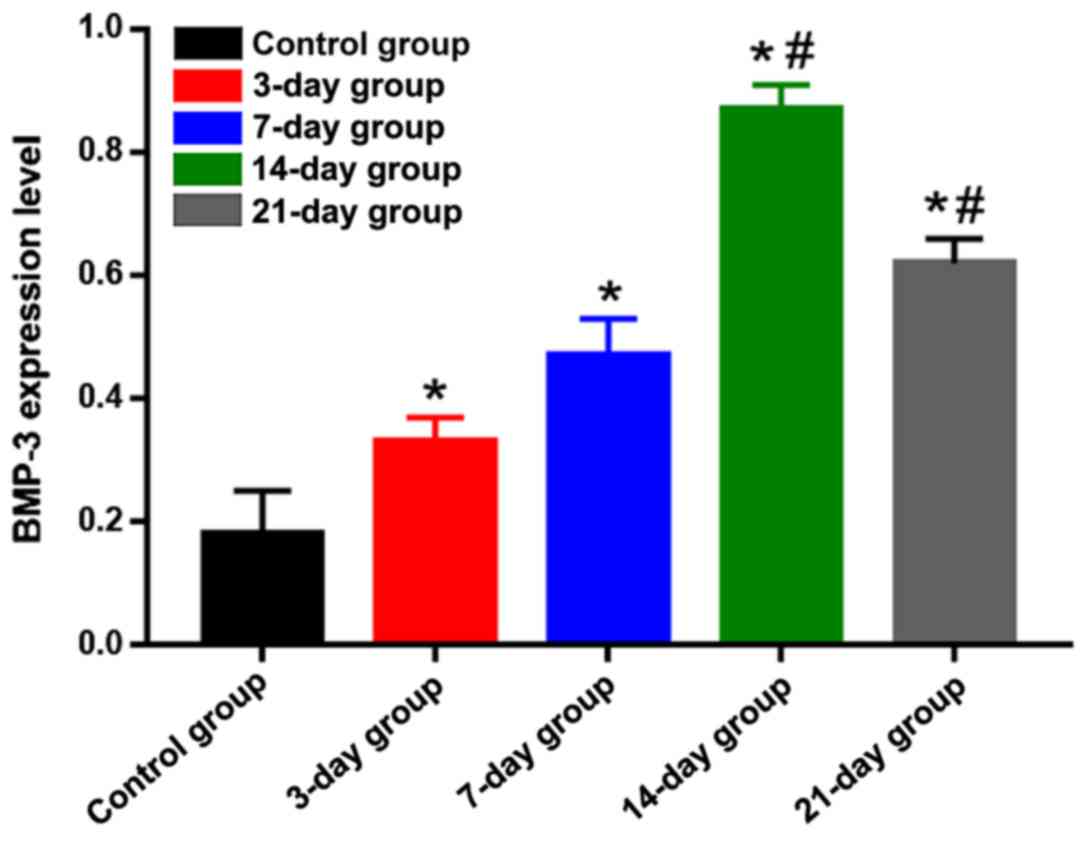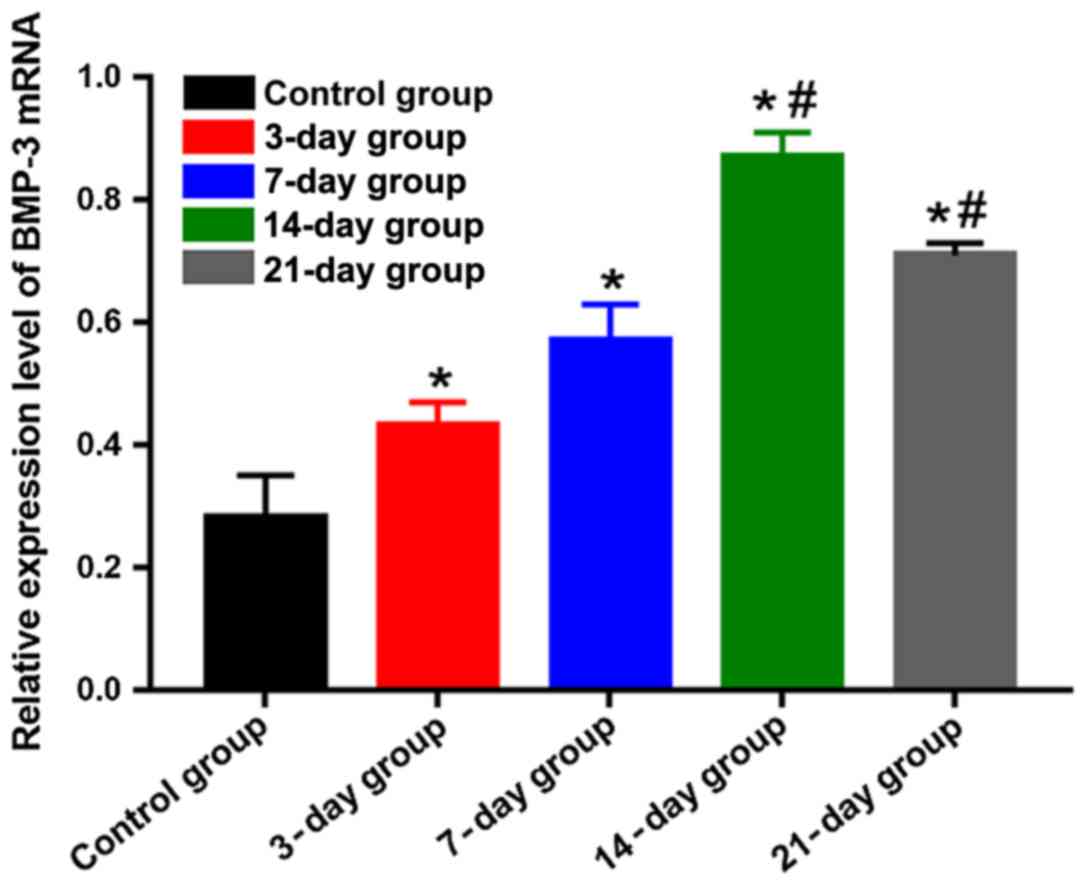|
1
|
Krishnan V and Davidovitch Z: Cellular,
molecular, and tissue-level reactions to orthodontic force. Am J
Orthod Dentofacial Orthop. 129(469): e1–32. 2006.
|
|
2
|
Ducy P and Karsenty G: The family of bone
morphogenetic proteins. Kidney Int. 57:2207–2214. 2000. View Article : Google Scholar : PubMed/NCBI
|
|
3
|
Chen S, Gluhak-Heinrich J, Martinez M, Li
T, Wu Y, Chuang HH, Chen L, Dong J, Gay I and MacDougall M: Bone
morphogenetic protein 2 mediates dentin sialophosphoprotein
expression and odontoblast differentiation via NF-Y signaling. J
Biol Chem. 283:19359–19370. 2008. View Article : Google Scholar : PubMed/NCBI
|
|
4
|
Daluiski A, Engstrand T, Bahamonde ME,
Gamer LW, Agius E, Stevenson SL, Cox K, Rosen V and Lyons KM: Bone
morphogenetic protein-3 is a negative regulator of bone density.
Nat Genet. 27:84–88. 2001. View
Article : Google Scholar : PubMed/NCBI
|
|
5
|
Bahamonde ME and Lyons KM: BMP3: To be or
not to be a BMP. J Bone Joint Surg Am. 83-A Suppl 1:S56–S62.
2001.
|
|
6
|
Livak KJ and Schmittgen TD: Analysis of
relative gene expression data using real time quantitative PCR and
the 2 (Delta Delta C(T)) method. Methods. 25:402–408. 2001.
View Article : Google Scholar : PubMed/NCBI
|
|
7
|
Ren Y, Maltha JC and Kuijpers-Jagtman AM:
Optimum force magnitude for orthodontic tooth movement: A
systematic literature review. Angle Orthod. 73:86–92.
2003.PubMed/NCBI
|
|
8
|
Dibart S, Yee C, Surmenian J, Sebaoun JD,
Baloul S, Goguet-Surmenian E and Kantarci A: Tissue response during
Piezocision-assisted tooth movement: A histological study in rats.
Eur J Orthod. 36:457–464. 2014. View Article : Google Scholar : PubMed/NCBI
|
|
9
|
Wise GE and King GJ: Mechanisms of tooth
eruption and orthodontic tooth movement. J Dent Res. 87:414–434.
2008. View Article : Google Scholar : PubMed/NCBI
|
|
10
|
Nagaie M, Nishiura A, Honda Y, Fujiwara S
and Matsumoto N: A comprehensive mixture of tobacco smoke
components retards orthodontic tooth movement via the inhibition of
osteoclastogenesis in a rat model. Int J Mol Sci. 15:18610–18622.
2014. View Article : Google Scholar : PubMed/NCBI
|
|
11
|
Garlet TP, Coelho U, Silva JS and Garlet
GP: Cytokine expression pattern in compression and tension sides of
the periodontal ligament during orthodontic tooth movement in
humans. Eur J Oral Sci. 115:355–362. 2007. View Article : Google Scholar : PubMed/NCBI
|
|
12
|
Dilsiz A, Kiliç N, Aydin T, Ates FN, Zihni
M and Bulut C: Leptin levels in gingival crevicular fluid during
orthodontic tooth movement. Angle Orthod. 80:504–508. 2010.
View Article : Google Scholar : PubMed/NCBI
|
|
13
|
Weltman B, Vig KW, Fields HW, Shanker S
and Kaizar EE: Root resorption associated with orthodontic tooth
movement: A systematic review. Am J Orthod Dentofacial Orthop.
137:462–476. 2010. View Article : Google Scholar : PubMed/NCBI
|
|
14
|
Allendorph GP, Vale WW and Choe S:
Structure of the ternary signaling complex of a TGF-beta
superfamily member. Proc Natl Acad Sci USA. 103:7643–7648. 2006.
View Article : Google Scholar : PubMed/NCBI
|
|
15
|
Bami M, Mavrogenis AF, Angelini A,
Milonaki M, Mitsiokapa E, Stamoulis D and Soucacos PN: Bone
morphogenetic protein signaling in musculoskeletal cancer. J Cancer
Res Clin Oncol. 142:2061–2072. 2016. View Article : Google Scholar : PubMed/NCBI
|
|
16
|
Hino J, Nishimatsu S, Nagai T, Matsuo H,
Kangawa K and Nohno T: Coordination of BMP-3b and cerberus is
required for head formation of Xenopus embryos. Dev Biol.
260:138–157. 2003. View Article : Google Scholar : PubMed/NCBI
|
|
17
|
Matsubara T, Kida K, Yamaguchi A, Hata K,
Ichida F, Meguro H, Aburatani H, Nishimura R and Yoneda T: BMP2
regulates Osterix through Msx2 and Runx2 during osteoblast
differentiation. J Biol Chem. 283:29119–29125. 2008. View Article : Google Scholar : PubMed/NCBI
|
|
18
|
El-Sayed Fawzy KM, Dörfer C, Ungefroren H,
Kassem N, Wiltfang J and Paris S: Effect of Emdogain enamel matrix
derivative and BMP-2 on the gene expression and mineralized nodule
formation of alveolar bone proper-derived stem/progenitor cells. J
Craniomaxillofac Surg. 42:568–576. 2014. View Article : Google Scholar : PubMed/NCBI
|
|
19
|
Muraoka R, Nakano K, Kurihara S, Yamada K
and Kawakami T: Immunohistochemical expression of heat shock
proteins in the mouse periodontal tissues due to orthodontic
mechanical stress. Eur J Med Res. 15:475–482. 2010. View Article : Google Scholar : PubMed/NCBI
|
|
20
|
Koch FP, Weinbach C, Hustert E, Al-Nawas B
and Wagner W: GDF-5 and BMP-2 regulate bone cell differentiation by
gene expression of MSX1, MSX2, Dlx5, and Runx2 and influence OCN
gene expression in vitro. Int J Periodontics Restorative Dent.
32:285–293. 2012.PubMed/NCBI
|
|
21
|
Wang Y, Gao S, Jiang H, Lin P, Bao X,
Zhang Z and Hu M: Lithium chloride attenuates root resorption
during orthodontic tooth movement in rats. Exp Ther Med. 7:468–472.
2014. View Article : Google Scholar : PubMed/NCBI
|
|
22
|
Bao X, Hu M, Zhang Y, Machibya F, Zhang Y,
Jiang H and Yu D: Effect of fangchinoline on root resorption during
rat orthodontic tooth movement. Korean J Orthod. 42:138–143. 2012.
View Article : Google Scholar : PubMed/NCBI
|
















